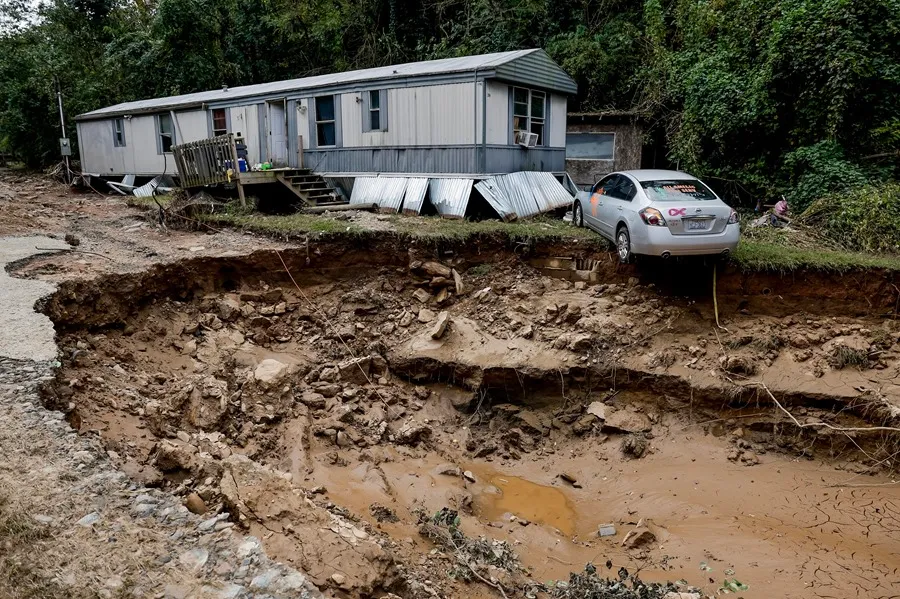International
Helene, the violent hurricane that destroyed the southeastern United States

Hurricane Helene is one of the extreme climatic events that have starred this 2024 after leaving more than 150 direct deaths and billions of dollars in losses in six states of the southeastern United States, according to preliminary figures.
The deadly Helene, which in the continental United States has only been surpassed by Katrina (2005), ended with more than 150 deaths, at least a hundred in North Carolina, in addition to leaving a path of destruction that reached the mountainous area of that state with special virulence.
After impacting Central America and the Yucatan Peninsula, Helene made landfall on September 26 with winds of 225 kilometers per hour in the Big Bend region of Florida, in the northwest of that state, as the most powerful cyclone in that region since records have been available.
From Florida, where it arrived as a major hurricane, and while it weakened progressively to become a tropical depression, Helene continued on land through Georgia, South Carolina, North Carolina, Tennessee and Virginia.
North Carolina was the one that took the worst part, not only for the number of deaths but for the economic losses, which amount to more than 59.6 billion dollars, according to an update from the state government released this month.
The historic rainfall of up to 76 centimeters caused floods and landslides in this state, which caused serious damage, and long-term, both in homes and in public infrastructure and the agricultural industry.
Million-dollar economic losses
Quantifying at this time the economic losses in all the states impacted by Helene, which generated strong winds and tornadoes, is difficult because there are discrepancies in the damage assessment since it produced “a large-scale disaster,” as Mónica Escaleras, professor of the Department of Economics at Florida Atlantic University (FAU), told EFE.
“The widespread nature of the damage, the diversity of affected sectors and ongoing recovery efforts” are factors that prevent an accurate estimate at present, he added.
Escaleras believes, however, that Helene is a reflection of how in recent years “extreme weather events have become increasingly frequent and intense, altering infrastructure and supply chains.”
A preliminary report from the Institute of Agricultural and Food Sciences of the University of Florida (UF/IFAS) estimates that agricultural losses in this southern state due to Helene can range between 40.3 and 162.2 million dollars, after destroying 6.1 million acres (2.4 million hectares) of arable land.
More hurricanes like Helene in the future
A key factor in Helene’s intensity were the high temperatures in the waters of the Gulf of Mexico, whose surfaces were at about 29.4 degrees Celsius when the system began to form.
A preliminary study by the World Weather Attribution network of scientists reflected that this temperature is the result of climate change, which made Helene’s effects worse, responsible for example for 10% more rain.
“It is expected that the growing occurrence of these events will generate higher insurance premiums and may lead to the withdrawal of coverage in high-risk areas, which will affect both the real estate and business sectors,” Escaleras said.
This possible future scenario can, on the other hand, affect unprotected communities more, such as the Hispanic one in the United States. The Climate Power organization revealed last week a report that shows that Latino communities have been the great victims of the extreme weather events that occurred in 2024.
The report in question found that many Latino families in western North Carolina live in trailers flooded or destroyed by the storm, and that not mastering English they had obstacles when it came to receiving information about recovery tasks.
Antonieta Cádiz, executive director of the Climate Power In Action campaign, reminded EFE of the case of the workers of a plastics factory in Erwin (Tennessee) who died after a negligence in their evacuation, which was not carried out due to the imminent effects of Helene, employees who were mostly Hispanic.
The above, he said, is a sample of the disproportionate and “deep inequalities” that affect the Hispanic community when it comes to extreme weather events.
International
Meta Says Russia Seeks to Ban WhatsApp for Defending Secure Communication

U.S. tech giant Meta, the parent company of WhatsApp, said that Russia is seeking to ban the messaging app because it “challenges government attempts to violate people’s right to secure communication.”
Russian authorities have encouraged citizens to switch to state-backed applications, and in August they already blocked WhatsApp’s calling feature.
On Friday, the communications regulator Roskomnadzor claimed that the platform was being used to “organize and carry out terrorist acts in the country, recruit perpetrators, and facilitate fraud and other crimes.”
“If the messaging service does not comply with Russian law, it will be completely blocked,” the regulator warned.
WhatsApp remains one of Russia’s most widely used messaging services, alongside Telegram.
Moscow is pressuring both platforms to grant authorities access to user data upon request for investigations into fraud and activities the government labels as “terrorist.”
Human rights advocates fear the demand could be used to target critics of the Kremlin, President Vladimir Putin, or the war in Ukraine.
International
Archbishop Wenski criticizes Trump’s deportation policies, calls for stronger push for reform

The Archbishop of Miami, Thomas Wenski, has called for increased pressure on the U.S. Congress to advance comprehensive immigration reform and criticized President Donald Trump’s mass deportation policies, arguing that they “do nothing to help.”
“We need to apply more pressure on Congress so lawmakers can make the necessary changes. It is also important for the Administration to listen to our voice. We do not want to be anyone’s enemy—we are Americans,” Wenski said in an interview with EFE.
The religious leader, who heads one of the dioceses with the largest Latino and Haitian populations in the United States, issued a call to defend the rights of migrants. He also emphasized that the U.S. Conference of Catholic Bishops (USCCB) has maintained a strong and public stance in favor of migrants for decades.
International
Trump relaunches diplomatic push to finalize U.S.-Backed peace plan for Ukraine War

U.S. President Donald Trump announced on Tuesday that his diplomatic team will resume meetings with delegations from Russia and Ukraine in an effort to pressure both sides to accept the peace plan proposed by Washington to end the war in Ukraine.
As part of this new round of talks, U.S. Special Envoy Steve Witkoff will travel to Moscow to meet with Russian President Vladimir Putin. Meanwhile, Army Secretary Dan Driscoll will hold discussions with Ukrainian representatives to narrow differences on the remaining points of the agreement.
Trump also confirmed his intention to meet personally with Ukrainian President Volodymyr Zelensky and with Putin, though he emphasized that such meetings will only take place “when the agreement is fully finalized or in its final stage.”
The president claimed that his administration has made “tremendous progress” toward resolving the conflict and reiterated that the war “never would have started” if he had been in the White House at the onset of the crisis.
The U.S.-backed peace plan consists of 28 points and has been revised following feedback from both sides. According to Trump, only “a few points of disagreement” remain under active discussion.
One of the most controversial aspects of the proposal is the suggestion that Ukraine cede parts of the Donbas region to Russia and limit the size of its armed forces. Kyiv is working closely with Washington to soften these clauses in search of an arrangement that does not compromise its sovereignty or security.
With this diplomatic push, Trump aims to solidify his role as the main mediator in the conflict and steer the war toward a political resolution after years of devastation, humanitarian crisis, and rising global geopolitical tensions.
-

 International4 days ago
International4 days agoTrump relaunches diplomatic push to finalize U.S.-Backed peace plan for Ukraine War
-

 International4 days ago
International4 days agoBolsonaro misses appeal deadline, faces imminent prison order by Brazil’s Supreme Court
-

 Central America3 days ago
Central America3 days agoPanama reinforces security with new helicopters and Super Tucano Aircraft purchases
-

 International4 days ago
International4 days agoMan pleads not guilty in Liverpool parade incident that injured more than 130
-

 International4 days ago
International4 days agoMacron to announce new voluntary military service amid rising security concerns in Europe
-

 Central America3 days ago
Central America3 days agoTrump urges hondurans to back conservative candidate Nasry Asfura in november elections
-

 Central America1 day ago
Central America1 day agoTrump Pardons Former Honduran President Hernández and Warns of Aid Cuts Ahead of Election
-

 International3 days ago
International3 days agoArchbishop Wenski criticizes Trump’s deportation policies, calls for stronger push for reform
-

 Central America3 days ago
Central America3 days agoWashington calls for oversight as Honduras faces allegations of electoral interference
-

 International1 day ago
International1 day agoMeta Says Russia Seeks to Ban WhatsApp for Defending Secure Communication
-

 Central America19 minutes ago
Central America19 minutes agoHonduras’ China–Taiwan Future Hinges on Sunday’s Presidential Election






























